Cliff Swallow Collecting Nesting Material photos by Larry Jordan
I was headed to Dye Creek Preserve yesterday to find a location for installing Burrowing Owl habitat when I witnessed something I had never seen before. More about that in a moment.
Dye Creek Preserve is a property near Red Bluff, California, managed by The Nature Conservancy. You can see a list of the birds we saw there on a recent Audubon outing here.
It was a cold, blustery morning, with a storm moving in quicker than expected. On route to the preserve, I was greeted with at least fifty Cliff Swallows on the side of the road, braving the high winds to gather nesting material near a local orchard. I had to pull over and watch, having never observed this behavior before.
The thing that really caught my eye as I pulled to the side of the road was a male Cliff Swallow diving down to mate with the female as she gathered grass for the nest. Opportunistic, I thought to myself.
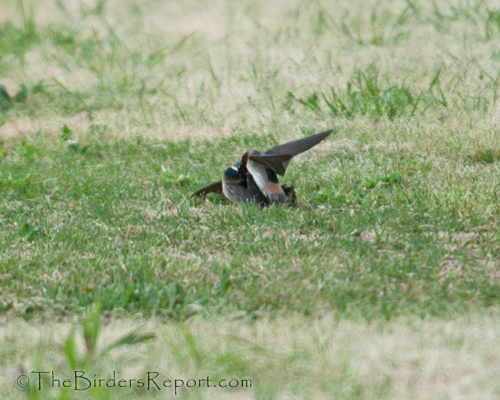
According to Birds of North America Online1, the Cliff Swallow “pair bond is more accurately a form of “mutual tolerance” of the other sex at the nest.”
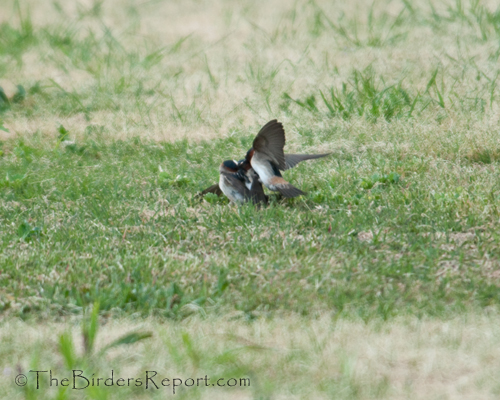
Many of the females grabbed nesting material quickly, only touching the ground momentarily, and taking off again.
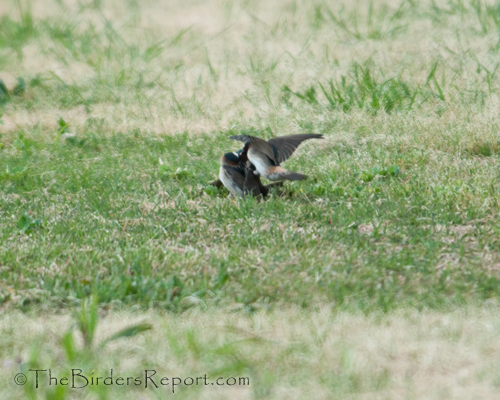
If they stayed grounded for more than a few seconds, they were likely to have at least one male trying to copulate with them, sometimes multiple males like the two shown in these photos.
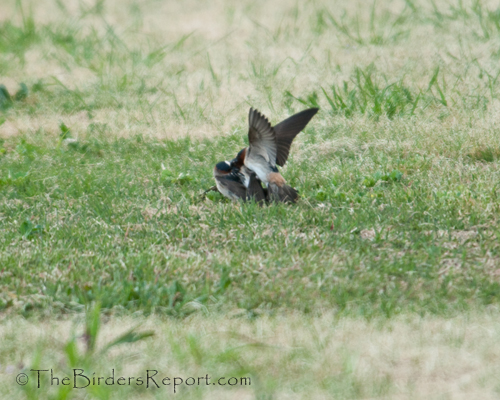
These are called extra-pair copulations. Both males resident at a colony and nonresident males engage in extra-pair copulations (EPC)1.
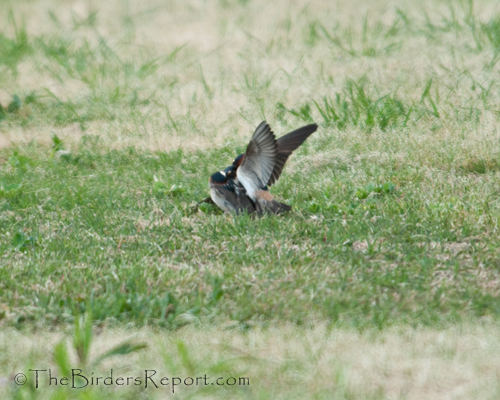
Females sometimes resist, other times accept EPCs1.
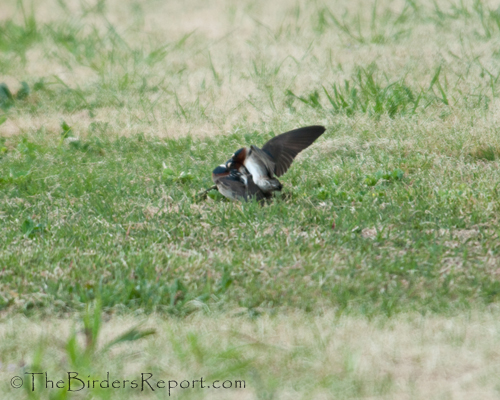
Sometimes males erroneously attempt to mate with another male. You can imagine this doesn’t go over well.
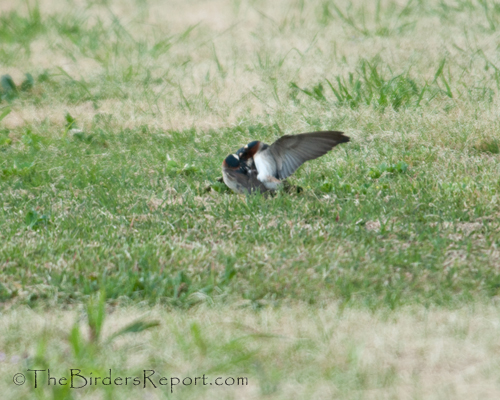
When gathering mud or collecting grass for nest lining, both sexes flutter wings above back to prevent being attacked by males seeking EPCs1 (see second photo in post).
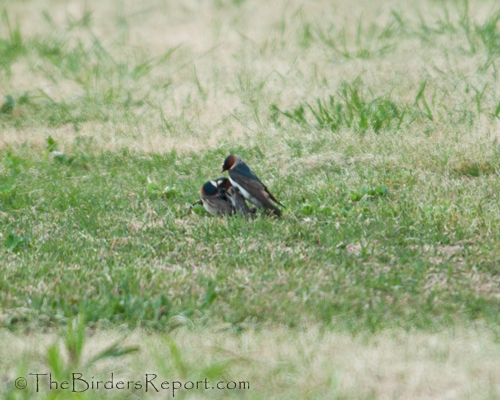
I believe these photos show one female being attacked by two males but only the swallows know for sure.
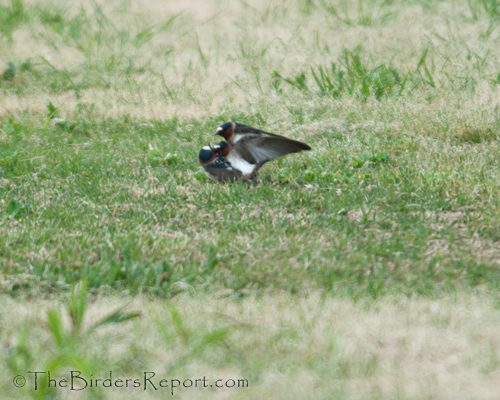
Some of these incidents appeared to be consensual and some appeared to be fights or mobbings.
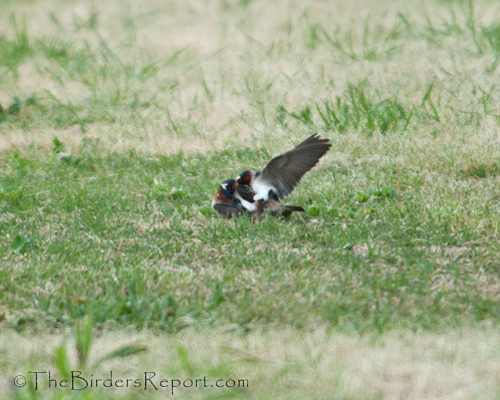
This practice probably leads to diversity in the colony and is a positive force in the conservation of the Cliff Swallow as a species, however, I’m sure some females feel that it is just better to be quick when collecting nesting material or mud for the nest.
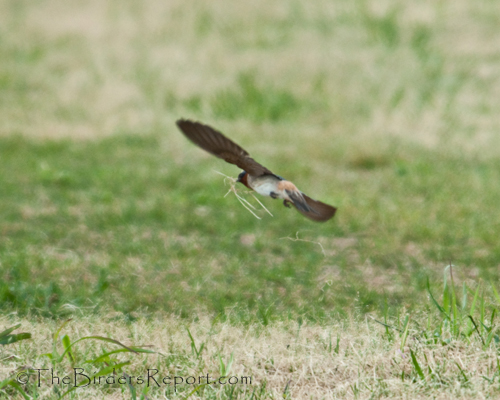
1 Reference: Birds Of North America Online, http://bna.birds.cornell.edu/bna/species/149/articles/behavior

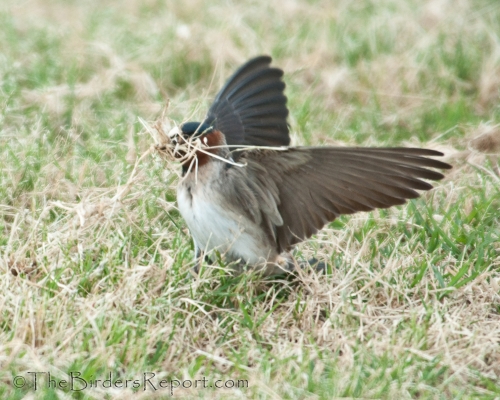
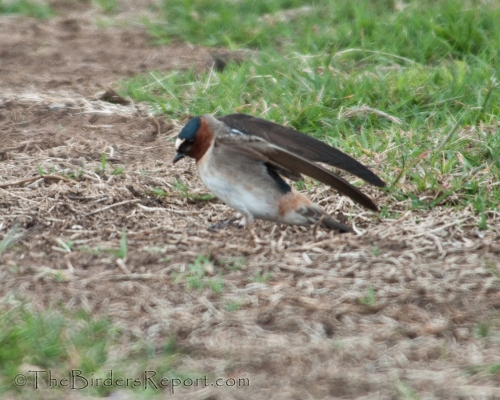
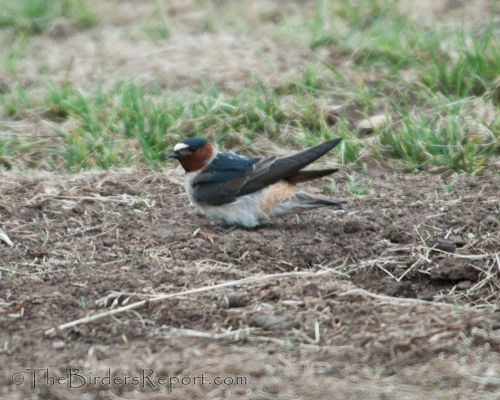








Comments on this entry are closed.
Sounds like its tough to be a female barn swallow! I rarely see barn swallows on the ground, so those scuffles are definitely interesting.
I’m looking forward to your next post on the outstanding work you are doing for the Burrowing Owls!
.-= Amber Coakley´s last blog ..Elegance =-.
Very colorful bird! All I see around here is seagulls, pigeons, chickadees, and sometimes, blue jays and cardinals..
.-= Mumsy´s last blog ..Q is For Quiet Quitting =-.
What beautiful fellows & photos!
Guess it’s a smart move that they take any opp. they can get 🙂
Or maybe they like a threesome? 😉
I saw to male sparrows go at each other’s throats the other day. Never seen anything like it. They were really up for killing each other, not heeding me or the dogs being one meter away from them.
.-= NicoleB, Egypt´s last blog ..Walk around the old sewers in Hadaba =-.
So, the male swallows do not gather nesting material?
.-= flowergirl´s last blog ..Tiger spotting at Ranthambhore =-.
Interesting post and awesome photos, Larry! I’ve seen the same thing happening with mallard ducks. I would have loved to have seen the Cliff Swallows up close.
.-= Eileen´s last blog ..Weekend Reflections =-.
@Amber I agree! Apparently Barn Swallows also engage in extra-pair copulation and the males have some pretty intense fights.
I have at least two more Burrowing Owl habitats to install but the chances of them being used this season is slim at this point. I’ll keep you informed!
@Mumsy thanks for stopping by with a comment
@Nicole I think birds in general are opportunistic but not all are polygamous. Actually, I think most birds are monogamous and some mate for life.
I am guessing that the sparrows you saw fighting were House Sparrows? I have seen them in knock down, drag out fights, tumbling on the ground
@Flowergirl yes the male Cliff Swallow usually starts the nest building before pairing up but it looks to me like they have other intentions while gathering nesting material out in the field 😛
@Eileen thank you very much. I have seen Mallards mating and I remember wondering if the female was going to drown but they always come up and do a little dance afterward. I was lucky to be driving past the orchard just as these swallows were engaging in this activity. Sometimes you can simply be in the right place at the right time 🙂
Fantastic post – as long as you don’t anthropomorphize too much, at which point the behavior becomes, uh, just plain disturbing!
I’m watching rock pigeons court & mate (hey, I live in NYC!) and have been wondering about the disparity between males and females regarding sex. The makes seem to be in hormonal over-drive, making overtures to any female in the area, while the females are quite blase and usually try to avoid the advances. Sometimes a male will start “driving” a female and doing his courtship routine (cooing, puffing up, etc.) while her mate is right there, doing his own courting! Unlike the swallows you describe, I’ve never seen any “non-consensual” copulation, since actual copulation, in my observation, always happens after a mutual display of head-bobbing and sometimes even apparent feeding of the female by the male.
But the insistent advances of the males makes me wonder if there are more males than females, or what is the explanation for courting already-paired and uninterested females. Any insight would be appreciated.
Thanks for the terrific post.
.-= Out walking the dog´s last blog ..Thank You, NYC Park Workers =-.
Yepp, they were house sparrows.
Funny little featherballs 🙂
.-= NicoleB, Egypt´s last blog ..Friday birding at the Golf course =-.